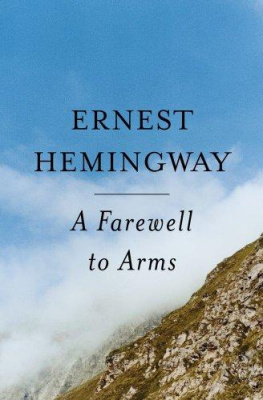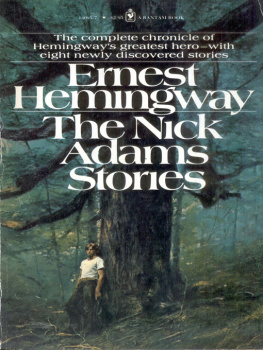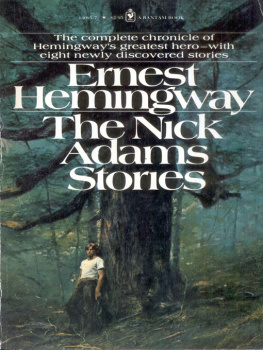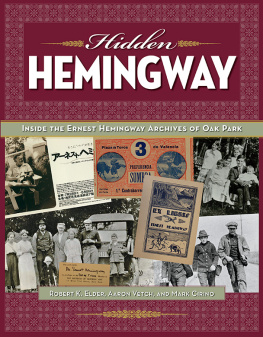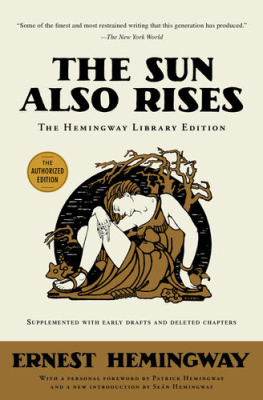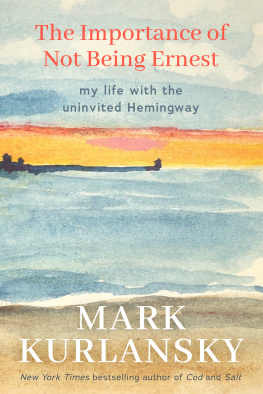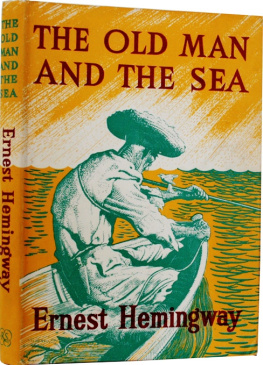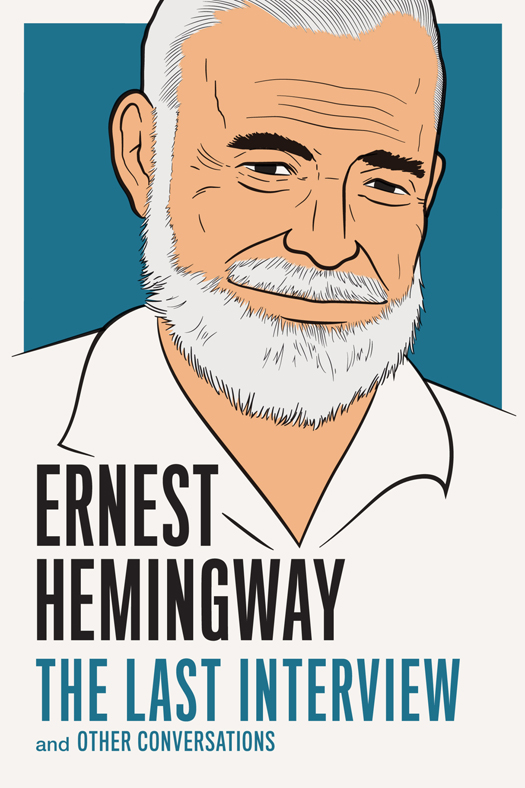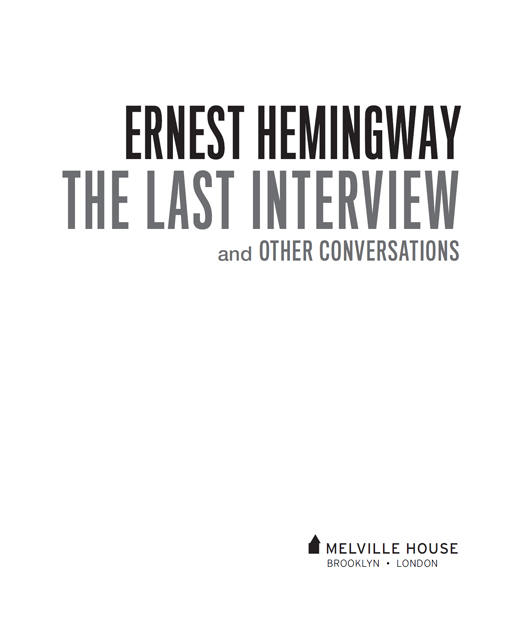ERNEST HEMINGWAY: THE LAST INTERVIEW AND OTHER CONVERSATIONS
Copyright 2015 by Melville House Publishing
Ernest Hemingway, The Art of Fiction No. 21, interview by George Plimpton, Issue No. 18, Spring 1958. Copyright 1958 by The Paris Review, used by permission of The Wylie Agency LLC.
Hemingway in Cuba Theresa Manning. First published in The Atlantic Monthly in August 1965.
Dropping in On Hemingway The Toronto Star. Reprinted with permission by Torstar Syndication Services.
Life in the Afternoon by Hemingway Foreign Rights Trust. First published in Esquire in May 1962.
First Melville House printing: December 2015
Melville House Publishing
46 John Street
Brooklyn, NY 11201
and
8 Blackstock Mews
Islington
London N4 2BT
mhpbooks.comfacebook.com/mhpbooks@melvillehouse
eBook ISBN: 978-1-61219-523-0
Library of Congress Control Number: 2015955748
v3.1
CONTENTS
Interview by George Plimpton
The Paris Review
May 1954
Interview by Robert Manning
The Atlantic Monthly
December 1954
Interview by Lloyd Lockhart
The Star Weekly Magazine
April 1958
Interview by Robert Emmett Ginna
Esquire
May 1958
ERNEST HEMINGWAY, THE ART OF FICTION, NO. 21
INTERVIEW BY GEORGE PLIMPTON
THE PARIS REVIEW
MAY 1954
HEMINGWAY: You go to the races?
INTERVIEWER: Yes, occasionally.
HEMINGWAY: Then you read the Racing Form There you have the true art of fiction.
Conversation in a Madrid caf, May 1954
Ernest Hemingway writes in the bedroom of his house in the Havana suburb of San Francisco de Paula. He has a special workroom prepared for him in a square tower at the southwest corner of the house, but prefers to work in his bedroom, climbing to the tower room only when characters drive him up there.
The bedroom is on the ground floor and connects with the main room of the house. The door between the two is kept ajar by a heavy volume listing and describing The Worlds Aircraft Engines. The bedroom is large, sunny, the windows facing east and south letting in the days light on white walls and a yellow-tinged tile floor.
The room is divided into two alcoves by a pair of chest-high bookcases that stand out into the room at right angles from opposite walls. A large and low double bed dominates one section, oversized slippers and loafers neatly arranged at the foot, the two bedside tables at the head piled seven-high with books. In the other alcove stands a massive flat-top desk with a chair at either side, its surface an ordered clutter of papers and mementos. Beyond it, at the far end of the room, is an armoire with a leopard skin draped across the top. The other walls are lined with white-painted bookcases from which books overflow to the floor, and are piled on top among old newspapers, bullfight journals, and stacks of letters bound together by rubber bands.
It is on the top of one of these cluttered bookcasesthe one against the wall by the east window and three feet or so from his bedthat Hemingway has his work deska square foot of cramped area hemmed in by books on one side and on the other by a newspaper-covered heap of papers, manuscripts, and pamphlets. There is just enough space left on top of the bookcase for a typewriter, surmounted by a wooden reading board, five or six pencils, and a chunk of copper ore to weight down papers when the wind blows in from the east window.
A working habit he has had from the beginning, Hemingway stands when he writes. He stands in a pair of his oversized loafers on the worn skin of a lesser kuduthe typewriter and the reading board chest-high opposite him.
When Hemingway starts on a project he always begins with a pencil, using the reading board to write on onionskin typewriter paper. He keeps a sheaf of the blank paper on a clipboard to the left of the typewriter, extracting the paper a sheet at a time from under a metal clip that reads These Must Be Paid. He places the paper slantwise on the reading board, leans against the board with his left arm, steadying the paper with his hand, and fills the paper with handwriting which through the years has become larger, more boyish, with a paucity of punctuation, very few capitals, and often the period marked with an X. The page completed, he clips it facedown on another clipboard that he places off to the right of the typewriter.
Hemingway shifts to the typewriter, lifting off the reading board, only when the writing is going fast and well, or when the writing is, for him at least, simple: dialogue, for instance.
He keeps track of his daily progressso as not to kid myselfon a large chart made out of the side of a cardboard packing case and set up against the wall under the nose of a mounted gazelle head. The numbers on the chart showing the daily output of words differ from 450, 575, 462, 1250, back to 512, the higher figure on days Hemingway puts in extra work so he wont feel guilty spending the following day fishing on the Gulf Stream..
A man of habit, Hemingway does not use the perfectly suitable desk in the other alcove. Though it allows more space for writing, it too has its miscellany: stacks of letters; a stuffed toy lion of the type sold in Broadway nighteries; a small burlap bag full of carnivore teeth; shotgun shells; a shoehorn; wood carvings of lion, rhino, two zebras, and a wart-hogthese last set in a neat row across the surface of the deskand, of course, books: piled on the desk, beside tables, jamming the shelves in indiscriminate ordernovels, histories, collections of poetry, drama, essays. A look at their titles shows their variety. On the shelf opposite Hemingways knee as he stands up to his work desk are Virginia Woolfs The Common Reader, Ben Ames Williams House Divided, The Partisan Reader, Charles A. Beards The Republic, Tarles Napoleons Invasion of Russia, How Young You Look by Peggy Wood. Alden Brooks Shakespeare and the Dyers Hand, Baldwins African Hunting, T. S. Eliots Collected Poems, and two books on General Custers fall at the battle of the Little Big Horn.
The room, however, for all the disorder sensed at first sight, indicates on inspection an owner who is basically neat but cannot bear to throw anything awayespecially if sentimental value is attached. One bookcase top has an odd assortment of mementos; a giraffe made of wood beads; a little cast-iron turtle; tiny models of a locomotive; two jeeps and a Venetian gondola; a toy bear with a key in its back; a monkey carrying a pair of cymbals; a miniature guitar; and a little tin model of a U.S. Navy biplane (one wheel missing) resting awry on a circular straw place matthe quality of the collection that of the odds-and-ends which turn up in a shoebox at the back of a small boys closet. It is evident, though, that these tokens have their value, just as three buffalo horns Hemingway keeps in his bedroom have a value dependent not on size but because during the acquiring of them things went badly in the bush, yet ultimately turned out well. It cheers me up to look at them, he says





